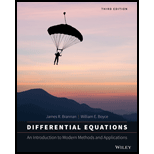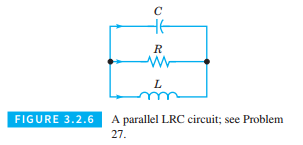
Concept explainers
Applications.
Electric Circuits. The theory of electric circuits, such as that shown in Figure 3.2.6, consisting of inductors, resistors, and capacitors, is based on Kirchhoff’s laws: (1) At any node (or junction), the sum of currents flowing into that node is equal to the sum of currents flowing into that node is equal to the sum of currents flowing out of that node, and (2) the net voltage drop around each closed loop is zero. In addition to Kirchhoff’s laws, we also have the relation between the current
Kirchhoff’s laws and the current-voltage relation for each circuit element provide a system of algebraic and differential equations from which the voltage and current throughout the circuit can be determined. Problems 27 through 29 illustrate the procedure just described.

Consider the circuit shown in the Figure 3.2.6. Let
(a) Applying Kirchhoff’s second law to the upper loop in the circuit, show that
In similar way, show that
(b) Applying Kirchhoff’s first law to either node in the circuit, show that
(c) Use the current-voltage relation through each element in the circuit to obtain the equations
(d) Eliminate
These equations form a system of two equations for the variables
Want to see the full answer?
Check out a sample textbook solution
Chapter 3 Solutions
Differential Equations: An Introduction to Modern Methods and Applications
Additional Math Textbook Solutions
Basic Business Statistics, Student Value Edition
Elementary Statistics (13th Edition)
Introductory Statistics
Graphical Approach To College Algebra
Elementary Statistics: Picturing the World (7th Edition)
- please answer these questionsarrow_forward2. Consider the following statement: For each natural number n, (3.2n+2.3n+1) is a prime number. (a) Explore this statement by completing the table below for n = 2,3 and two additional values of n of your choosing (notice n = 1 has been completed for you). One of your rows should contain a counterexample. n 1 3.2 2.3 +1 3.212.31 + 1 = 13 prime or composite? prime 2 3 (b) Write a formal counterexample argument for the statement using the template fromarrow_forwardPlease ensure that all parts of the question are answered thoroughly and clearly. Include a diagram to help explain answers. Make sure the explanation is easy to follow. Would appreciate work done written on paper. Thank you.arrow_forward
- Selon une économiste d’une société financière, les dépenses moyennes pour « meubles et appareils de maison » ont été moins importantes pour les ménages de la région de Montréal, que celles de la région de Québec. Un échantillon aléatoire de 14 ménages pour la région de Montréal et de 16 ménages pour la région Québec est tiré et donne les données suivantes, en ce qui a trait aux dépenses pour ce secteur d’activité économique. On suppose que les données de chaque population sont distribuées selon une loi normale. Nous sommes intéressé à connaitre si les variances des populations sont égales.a) Faites le test d’hypothèse sur deux variances approprié au seuil de signification de 1 %. Inclure les informations suivantes : i. Hypothèse / Identification des populationsii. Valeur(s) critique(s) de Fiii. Règle de décisioniv. Valeur du rapport Fv. Décision et conclusion b) A partir des résultats obtenus en a), est-ce que l’hypothèse d’égalité des variances pour cette…arrow_forwardQ4 4 Points 3 Let A = 5 -1 Let S : R³ → R² be the linear transformation whose standard matrix is A. Let U : R² → R³ be the linear transformation whose standard matrix is AT (the transpose of A). Let P: R³ → R³ be the linear transformation which first applies S and then applies U. Let Q: R² → R² be the linear transformation which first applies U and then applies S. Find the standard matrix of P and the standard matrix of Q. Clearly indicate which is which in your work. Please select file(s) Select file(s) Save Answerarrow_forwardQ3 4 Points Let T: R4 → R³ be the linear transformation defined by the formula 11 x1+x3+2x4 T x2 + 3 + 24 Is −1 +222 +23 I i. (2 points) Find the standard matrix of T. ii (2 points) Determine if I is one-to-one and determine if I' is onto. Please select file(s) Select file(s)arrow_forward
- Algebra & Trigonometry with Analytic GeometryAlgebraISBN:9781133382119Author:SwokowskiPublisher:Cengage
 Elementary Linear Algebra (MindTap Course List)AlgebraISBN:9781305658004Author:Ron LarsonPublisher:Cengage Learning
Elementary Linear Algebra (MindTap Course List)AlgebraISBN:9781305658004Author:Ron LarsonPublisher:Cengage Learning Linear Algebra: A Modern IntroductionAlgebraISBN:9781285463247Author:David PoolePublisher:Cengage Learning
Linear Algebra: A Modern IntroductionAlgebraISBN:9781285463247Author:David PoolePublisher:Cengage Learning  Algebra: Structure And Method, Book 1AlgebraISBN:9780395977224Author:Richard G. Brown, Mary P. Dolciani, Robert H. Sorgenfrey, William L. ColePublisher:McDougal Littell
Algebra: Structure And Method, Book 1AlgebraISBN:9780395977224Author:Richard G. Brown, Mary P. Dolciani, Robert H. Sorgenfrey, William L. ColePublisher:McDougal Littell



